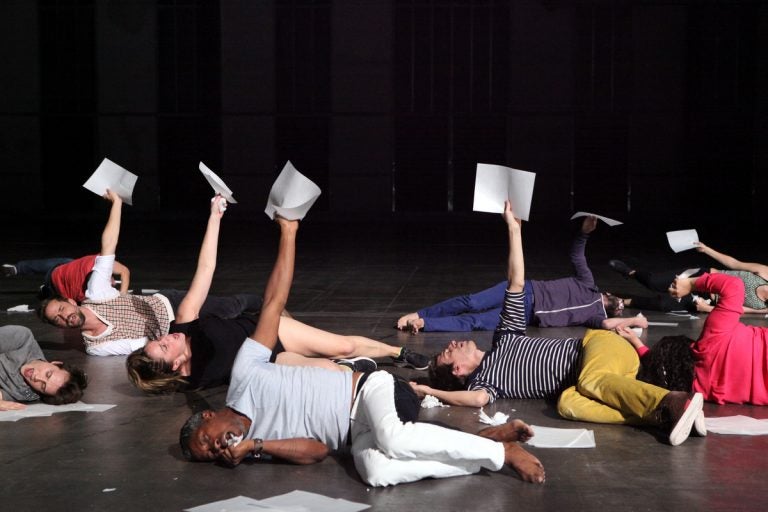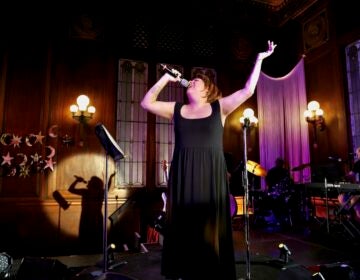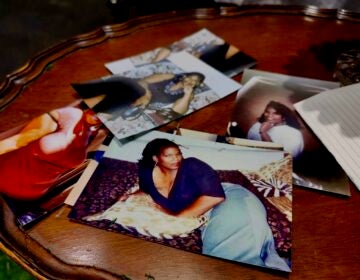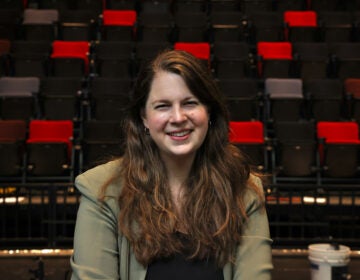Time for some boundary-pushing (and lots of dance) during Philly Fringe Festival 2018
For 18 days, the news arts season begins with another round of the unforeseen
Listen 5:29
The ensemble in French choreographer Boris Charmatz's "Manger," one of the dance shows FringeArts is bringing to this year's Philly Fringe festival. (Ursula Kaufmann)
The new arts season blasts off Thursday with the opening of this year’s Philadelphia Fringe Festival, 192 different productions during 18 days. The Philly Fringe, as it’s called, has come of age – this is the 22nd festival here. Yet it maintains its quotient of edgy ideas.
Consider a show opening next Friday, called “Stifters Dinge.” It’s named for a 19th-century Bohemian, Adalbert Stifter, who explored phenomenon we can’t name or explain. German composer-director Heiner Goebbels attempts a stage version of that exploration with his 70-minute performance installation – a play with no actors, a composition for five pianos but with no pianists. It’s essentially a no-man show. What you get is only the stagecraft – the lighting, the sounds, the mist and the like. You can develop the plot, or just focus on your own awareness while you witness it.
“Stifters Dinge” is one of 20 shows curated by FringeArts, the overseer of the festival, which pays for those productions and brings several from overseas. The curated Fringe — as opposed to the rest of the festival, a free-for-all produced by anyone who wants to be part of it — is heavy this year with dance. About 200 area residents have been rehearsing “Le Super Grand Continental,” choreographed by Montreal-based Sylvain Émard, who directed a smaller version (but still expansive) of his joyous dance at the 2012 Fringe; it’s a half-hour ode to movement, performed for free at the foot of the Art Museum steps.
Inside the museum, another Fringe-curated dance, “The Museum Workout,” invites you to wear your exercise clothes for high-energy calisthenics with Monica Bill Barnes and her longtime dancing partner Anna Bass, who’ll lead you in choreographed exercises through the galleries. (“Not for the faint of heart,” cautions the 140-page Fringe guide, available in print around town and on line.) “Caen Amour,” from American choreographer Trajell Harrell, uses 19th-century hoochie-coochie dancing as an inspiration to plumb the line between art and eroticism.
Meg Foley offers a four-person dance about memory and imagination called “The Undergrid,” with sculpture and text. In “Manger,” dancers chew through … well, lots of stuff … in French choreographer Boris Charmatz’s look at the nature of eating and digesting everything from food to information. “We envision a sort of meal in motion,” he says in the Fringe material.
Among the curated works are five by Tanya El Khoury, a feminist Arab theater artist who works in London and Beirut. All examine the tribulations refugees face, and one concerns audiences’ reactions to the shows, which have played around the world. Bryn Mawr College is co-sponsoring these.
There’s music and theater and circus, too, in the curated Fringe. Even though theater takes a back seat in the curated shows this year it’s the most produced art in the entire festival, which runs through eight neighborhoods. Eighty-five pieces of theater are offered, plus 28 dance performances, 22 “interdisciplinary” works that can’t be pigeonholed into a single art form, and music, visual art and film, spoken word and comedy/improv. You don’t even have to go to the Fringe to attend it — just log on to your device for 26 specially-created digital Fringe shows, all free.
As in past years, many of the region’s theater companies open their seasons with shows in the Fringe. Irish Heritage Theatre will present “Lay Me Down Softly,” a ’60s play set in the world of Irish boxing. Wilma Theater is presenting James Ijames’ “Kill Move Paradise,”about four people in the afterlife who consider the systemic violence that put them there. Almanac Dance Circus Theatre, which blends acrobatics and storytelling, stages “Jeanne/Jean/John/Jawn” indoors and outdoors in North Kensington.
The sometimes outrageous Bearded Ladies Cabaret offers “Do You Want a Cookie?” and transforms an old factory on North 10th Street into a setting for “part Great Cabaret Bake-Off, part irreverent romp through cabaret history.” That show is one of FringeArts’ curated productions. Tribe of Fools, which specializes in skewering Philly life with high-energy shows, looks at fandom and folly in “Fly Eagles Fly.”
Inside a cemetery, the much-respected Philadelphia Artists’ Collective — which prizes rarely performed material — will present “Mary Rose,” about a World War I soldier who comes back from the dead. It was written by J.M. Barrie, who wrote “Peter Pan.”
Another Philly stage company, EgoPo, remounts its 2009 Fringe show “Company,” a sensory experience in which you’re blindfolded and on your back, with text whispered in your ear. (Bring a pillow and blanket, the Fringe material says, and free milk and cookies will be available.) Revolution Shakespeare once more takes over Hawthorne Park in Queen Village, this time with an adaptation of “Troilus and Cressida.” Simpatico Theatre stages four solo performances in rep, each examining maleness in America. Brian Sanders’ dance company, JUNK — a Fringe staple — recreates ’60s Palm Springs in “Plunge” at Patio at Spring Arts, the outdoor lounge with a Palm Springs theme on Hamilton Street, near the new Rail Park.
Every night during the festival at around 10:30, the Fringe turns into a scene when actors, directors, designers and audiences mingle inside and outside bars at the FringeArts building, at Race Street and Columbus Boulevard. The late-night parties are programmed with DJs, cabaret and other live music. You pay for whatever you drink, but the entertainment’s free.
If you’re going to the Fringe, how do you know where to begin? The festival can appear daunting but in fact, it’s not. Leaping through the festival guide is a simple way to make choices — the curated FringeArts shows are well described, the rest of the bunch not so much. But you can get an idea what you’re getting into. Here’s a suggestion for anyone who wants to jump into the fray at the last minute, with no guidebook in hand:
Go to fringearts.com and click on “festival,” a choice at the top of the homepage that comes onto your screen. You’ll then see a list of days on the left side of the screen, including days outside the festival when shows are still running. Click on the day you’re able to go and survey all the shows. Each has a red box: “read more.” Click on it, and you’ll see whatever description FringeArts has of the show. You can reserve tickets, some of them free. Most shows are priced between $10 and $50, and mostly at the lower end of the scale.
The festival page also lets you filter shows by themes and by the neighborhoods where they appear.
The Philly Fringe is modeled after the huge one in Edinburgh, Scotland, and – like its sponsor, FringeArts, which presents shows all year – is an institution in the city. That’s strange — when you think about a festival on the fringe of traditional offerings, “institution” isn’t a word likely to come to mind. But over the years the Philly Fringe has gained many sponsors, aware of a large adventurous audience willing to take risks on work that could be solidly memorable or instantly forgettable or something in between.
This year, the major Fringe co-sponsor is The Met Philadelphia, the formerly run-down Metropolitan Opera House at Broad and Poplar Streets, originally built by Oscar Hammerstein. It’s undergoing a $56 million renovation with Live Nation as a major owner, and is expected to open as a 3,500-seat concert hall in December.
For a full festival schedule on the Web, go to fringearts.com.
Listen to the audio above to hear a conversation about this year’s Philly Fringe between Howard Shapiro and WHYY arts reporter Peter Crimmins.
WHYY is your source for fact-based, in-depth journalism and information. As a nonprofit organization, we rely on financial support from readers like you. Please give today.




